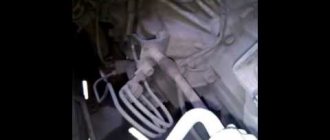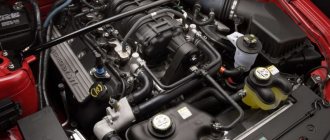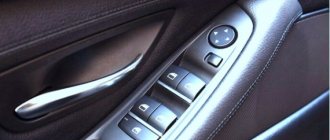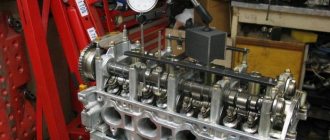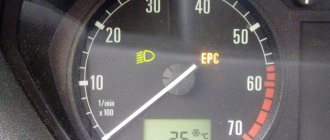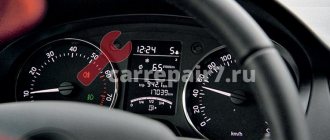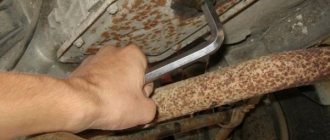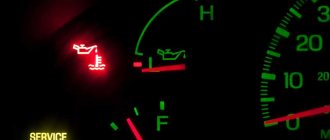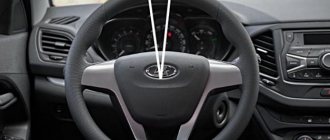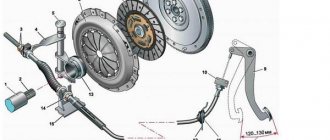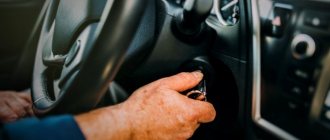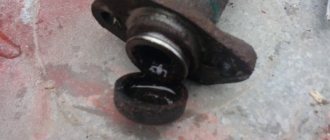The life of a motorist is connected with constant stress, that’s a fact. In addition to the dynamics of road traffic, which, in principle, does not allow the driver to relax, there are also unpleasant situations with the unexpected failure of the car. Precisely while moving, in traffic, or precisely far from home.
Such troubles include traditional ones: the brakes have failed and the clutch has disappeared. The most common question on the forums of car drivers of almost all brands and models is this: the clutch pedal has failed, help... help.
Of course, there are many reasons for a clutch to fail. We will try to consider several reasons that contribute to the fact that the clutch pedal does not return.
Why did the clutch pedal fail?
The clutch pedal is depressed
Here we will look at the causes and methods for eliminating them in stationary conditions. Either at a service station, or repairing the clutch yourself in the garage. Operations such as replacing or repairing the main clutch or control valve are completely doable in a garage, if you have a repair kit for the clutch master or slave cylinder.
So, why does the clutch pedal not return (the clutch pedal “fails”)?
- The clutch cable broke in the place where its tip is sealed. You are unlikely to fix this malfunction on the spot, although some people recommend carrying a spare cable with you? so that the faulty cable can be replaced. But, it’s problematic to carry every spare part and component with you;
- The return spring has either fallen off or burst. If the spring falls off, it returns to its place. If a spring breaks, then, as in the case of a cable, either in a “tug” or under its own power to a service station or to a garage. How to drive without a clutch? More on this below;
- Air has entered the hydraulic drive system. In this case, only bleeding the clutch to remove air can help;
- The clutch fork is broken. And in this case, the answer is clear - the clutch fork needs to be replaced;
- the clutch pedal has failed, but it is possible to engage the clutch briefly only by very sharply pressing the pedal, the fault is with the clutch master cylinder: defects in the mirror, defect or wear of the main clutch cuff. The problem is solved by replacing the clutch master cylinder.
If you cannot resolve the issue with car repair, then you can always use the services of a tow truck https://volok-evakuator.ru so that it delivers the car to the nearest service station for further repairs.
Clutch lost, how to get to the service station
Yet it happened - the clutch pedal fell through and did not return. Even with the help of a leg, it still doesn’t come back. It’s daytime, heavy traffic, and our task is to get to a car service center, to a garage, or at least to the nearest parking lot.
If the clutch is lost, there are three scenarios: ask someone to tow you, call a tow truck, and... get there yourself.
How to get there if the clutch is lost, you ask. It's not easy, but it's possible. And here are a couple of tips that have been tested by car people in practice.
- The engine must be turned off.
- We put the gear shift lever in first gear.
- We turn the ignition key and, at the same time as starting the engine, “give” the gas so that the car does not stall. The movement begins.
- Do not try to shift into second gear while driving. The transmission costs more than calling a tow truck.
In principle, you can start moving in the same way from second gear. But, in both cases, you need to remember several important nuances:
- At the moment when the pedal falls and the clutch is lost, try to stop the car either on a descent (slope) or on a straight section. But it’s not uphill at all. Stop on an incline, the clutchless method won't work.
- Warm up the engine before driving.
- Important! Do not forget that you will have to move in first, or maximum second, gear. Therefore, before you start driving, carefully consider the route: how many traffic lights are on your way, how many intersections, where and in what sequence you need to turn, and so on. If possible, plan your route to your destination in such a way that you always follow the main road (to avoid giving way).
- Don't forget to turn on your hazard lights.
- Remember, no one knows that you have lost your clutch, so when approaching a pedestrian crossing or traffic light, you do not need to maneuver. It's better to stop if you don't have time, and then repeat the procedure again.
- If you are not confident in your abilities, then the most optimal solution is a tug or tow truck.
Good luck on your journey. May your car's clutch never fail.
Situations when various breakdowns occur on a car while driving occur quite often. Such malfunctions include both minor breakdowns in the form of a punctured wheel, and more serious ones, for example, if the clutch pedal on a VAZ 2107 fails. This is not a very pleasant situation, especially when you urgently need to go somewhere. It’s even more unpleasant when trouble strikes you while stuck in a traffic jam or while away from home.
The clutch pedal has fallen - clutch malfunction
Hydraulics
— Check the brake fluid level in the clutch master cylinder reservoir. If the level is insufficient, add brake fluid to the normal level and try pressing the pedal. If the clutch appears, you are lucky, in this case you need to go to a service center or inspect all the hoses yourself, most likely the fluid is leaking somewhere. But in most cases this does not help. Then there is a very high probability that one of the hoses leading to the clutch master or slave cylinder has burst , so the required pressure is not created in the system. To solve this problem, you need to replace the worn hose.
The price of a hose is 300-500 rubles, the price of work in the service is from 500 rubles . When you look for a hose in stores, it is advisable that you have an old one with you - then you can compare the fittings and threads on them. It may turn out that there is no hose on sale for your model, then a brake hose for other models may be suitable. Ask the seller to find the part on which the fitting is screwed and screw on the old and new hose; if they screw on, feel free to buy it. Also don’t forget to buy brake fluid (it’s better to take 1 liter, the price is about 150 rubles )
Clutch cable
- may break somewhere inside or at the ends. The eye on the clutch pedal to which it is attached may also break off. In this case, the cable needs to be replaced, a new cable costs about 300-600 rubles, the price of work in the service is about 500 rubles .
Clutch release fork
— located on the gearbox, its service life is approximately 50-70 thousand km. If your meter already has similar numbers, or the fork was changed about the same mileage ago, then most likely there is a breakdown in it. To change the clutch fork, on most car models you need to remove or hang the gearbox.
We recommend: How to clean spark plugs from carbon deposits at home
For work in the service you will pay 1500-3000 rubles . It makes sense to think about replacing the clutch disc if you haven’t changed it for a long time (clutch disc replacement is usually every 70-80 thousand km), because the procedure for performing this work involves removing the box. They won’t charge you much more for the work, but you’ll immediately change the clutch at the same time. I also recommend changing the oil in the box at the same time, if it has not been changed for more than 50 thousand km.
Clutch master or slave cylinder
- perhaps one of these cylinders has “broken”, then you should replace the non-working clutch cylinder with a new one, or it is better to change both at once - both the working and the main one. After work, be sure to bleed the system and check for leaks at the connections. The price of work to replace the GCS or RCS in a car service is about 1500-2000 rubles .
What caused the problem?
Broken clutch pedal
So, if the clutch pedal in your vehicle has fallen, then first you need to determine the cause of the breakdown.
There can be many reasons, so your task, as a motorist, is to reliably identify them:
- The first and one of the most common causes is a broken clutch cable. Usually the cable breaks near the tip, on the engine compartment side. It is quite possible to solve such a malfunction on your own and right on the spot, but for this you will need the cable itself. You will learn more about the replacement below.
- Failure of the return spring of the clutch system (hereinafter - CC), which could either burst from wear or simply fly off. If the spring bursts, then there is only one way out - only replacement, so you need to go to the nearest service station either in tow, or as we will describe below. If the spring just flew off, then you can try to find it and put it in place.
- Often the pedal fails when air gets into the hydraulic drive. Driving such a vehicle will also be impossible until air is removed from the system. By the way, instructions for bleeding the system are available on our website, you can find them here.
- Failure of the CC fork can also cause the clutch pedal to drop. It is unlikely that you will be able to solve the problem on the spot, unless you are a car repairman. There is only one way out - replacing the element.
- Incorrect operation of the master cylinder CC, in particular, defects in the mirror, wear or failure of the cuff. In this case, the clutch pedal has failed, but periodically it can be returned to its place by pressing sharply. For normal driving of the car, it is necessary to replace the main cylinder of the system itself.
- Driven disk failure. As a result of this, if the clutch pedal fails, it will be very soft, you will feel it. Failure of the driven disk may be due to the appearance of defects, mechanical damage or deformation of the element. In addition, the cause may be a fluid leak from the hydraulic system or a pipeline breakdown. In this case, the driven disk could fail as a result of the breakdown of the main and working cylinders, or one of them.
Design features
The clutch consists of two main components - the drive and the mechanism itself. The drive ensures the transmission of force from the driver to the mechanism, and the mechanism directly disconnects the motor from the gearbox.
There are several types of drive used on cars:
- mechanical - the force in this type is performed through a system of levers and rods or through a cable;
- hydraulic - in which the driver’s effort is carried out by fluid;
- pneumatic - the force is carried out by air under pressure, used on freight transport and agricultural equipment;
- electronic - sensors monitor the position of the clutch pedal, and the electric motor turns it on or off.
Whatever type of drive is used on the car, it has one task - to transfer the driver’s force to the mechanism for disconnecting the engine and gearbox.
But the disconnection is performed by the clutch mechanism. It is divided into several classifications:
- According to work environment. There are dry and oil clutches. As for cars, the dry version has become widespread.
- By the number of driven disks. Single-disc, double-disc and multi-disc are used.
- According to the disc spin elements. In some, the disc is separated by means of spring-loaded levers, in another type - by a spring diaphragm.
The single-plate dry clutch is the most common type in passenger cars. In robotic boxes, it is possible to install a two-disc one.
The drive is working - we are looking for another reason
If the pedal fails, and you find out that the drive is in working order, then the reason is more serious - the clutch mechanism itself has broken down. There are several possible faults:
- the axis of the release fork gets stuck - the most “successful” type of breakdown;
- damage to the release bearing (clutch release);
- Damage to the diaphragm spring of the drive disc.
To accurately identify the cause of the malfunction, you need to completely disassemble the clutch mechanism and inspect it. To do this you will need a pit or overpass. Repairs are carried out only by replacing worn parts.
Design and principle of operation of the unit
The clutch system is a key component of any car equipped with a manual transmission. The principle of operation of the mechanism is to disconnect and connect the engine crankshaft with the transmission. This is how smooth acceleration or the same smooth deceleration of the car is carried out. In addition, the operating principle of a manual gearbox involves turning off the torque when shifting.
The clutch includes several main components. This is the drive disk or basket. The part may also be called a pressure plate. The mechanism contains a release bearing, a clutch disc or driven disc, and a flywheel. There is a clutch fork.
Reasons why the clutch pedal may fail
If the clutch pedal on a car fails, then there is little pleasure in it. The clutch is not a brake or an accelerator, but without this pedal further operation of the car is also practically impossible. This type of breakdown can be repaired at the nearest service station or at home. To continue further movement, you will need to purchase a repair kit for the VAZ 2107. However, you should not rush, since it is more rational to first find out the true causes of the malfunction.
This is interesting! If the clutch pedal disappears along the way, it is not necessary to call technical assistance. You can get home or to the nearest service station if you turn on gear 1, start the engine and drive at a constant speed. If you drive far, it is advisable to start with speed 2.
When the clutch disappears, the driver immediately asks himself why the pedal failed and what to do next. The main thing is not to panic, and to look for a way out of the situation with small attempts. First, you need to figure out what caused the clutch pedal to fail on the VAZ 2107. The following reasons contribute to the development of such a malfunction:
- This is often caused by a hose that breaks at its connection point. Of course, it is almost impossible to fix this type of breakdown on your own, since this will require you to buy a new cable or carry it with you.
- Malfunction of the return mechanism, which is implemented by a spring. This spring may burst or fly off. Most often it bursts, but if diagnostics show that the spring has jumped off, then it can be put back in place and you can continue driving the car.
- Air entering the hydraulic drive structure. This phenomenon is extremely rare, but if the clutch is lost, then you should not immediately rule out this cause. To fix the problem, you will need to bleed the hydraulic drive, which will release air. Only after bleeding the system will you be able to continue driving the car.
- Mechanism malfunction. A malfunction of the mechanism can be foreseen in advance if you listen and pay close attention to changes in the driving behavior of the car. These changes include: the clutch engages more sharply each time you press the pedal.
Why the ECM detects error “P0830”, video explanation
Praise to the author! I am also a terrible car enthusiast, albeit with little experience... I also had right-hand drive ones, but unfortunately, they are not convenient with our traffic. I now have probably the most boring Toyota model. For almost 2 years of owning this car, I had no problems at all, it burned out once a light bulb in the foot, and I changed the brakes and oil according to plan, despite the fact that the car is 8 years old, the mileage is about 150 thousand. It accelerates quickly, drives smoothly, and is maneuverable. spacious trunk and for its size a very comfortable and spacious interior, dad feels completely comfortable in the back seat, and he is a large man. After a night in a windswept parking lot at minus 35, it started up and didn’t even sneeze once. The stove heats perfectly, the air conditioner cools quickly, the consumption is 6-7 liters of 92 in the city. engine 1.5. 106 horses, + with its size it will fit into any hole in the parking lot. In short, the car is just great. )))
How to drive without a clutch?
Let’s say you roughly or exactly understand what the breakdown occurred, how can you now get to your home or service center? You can get there on your own , but if you do something wrong, it risks breaking the gearbox, failure of synchronizers and other components of the gearbox. If you have money and time, it is better to find a driver who can tow you, or call a tow truck. It will be cheaper than if the gearbox breaks down.
If you still decide to go on your own , then read on. The easiest option is to drive in first gear. Since there is no clutch, then with the engine turned off, we immediately engage first gear (it will engage without a clutch), and in this position we start the car. When you turn the ignition key to the “starter” position, the car will immediately move and start, there will be slight jerks. Consider that you have set off and are already driving.
Be careful, because when you press the brake pedal, the car will continue to pull forward, because there is no way to press the clutch. Therefore, in order to stop, you must either first try to turn off first gear (catch the speed when it turns off without jamming), then brake, or simply turn off the car.
Then there are 2 options - either drive in first gear to your destination (this may be unrealistic if you drive very far), or, at your own peril and risk, learn to change gears without a clutch.
Gear shift
To change gear without a clutch , it is important to catch the speed at which it will shift easily. This method is also called “pushing” gear shifting. After holding the gas for some time, you can suddenly release it and try to switch while the speed drops. But you should not press the lever with force; if you make it crunch and make the wrong movement with the lever, the box may become unusable.
Therefore, move the lever smoothly, you will feel for yourself when the gears have the required speed for engagement, the lever can even engage the gear itself if you press it a little in its direction. At the same time, sharpness may be required to switch. If you catch the desired speed and the gear does not engage itself, you need to sharply, but not forcefully, try to shift it. Once you get the hang of it, it will work out.
The most important thing here is to reduce the number of gear changes to a minimum, that is, if, for example, you drive very far along the highway, you can accelerate using a 1-3-5 or 1-2-4 gear scheme. And one more thing - it’s better to get there in 2-3 gears than to unsuccessfully stick in 4th, thereby damaging the gearbox. If you successfully switch to 4th-5th gear, try to calculate the speed based on the road situation so that you don’t have to brake or shift too much. Be extremely careful and careful!
Gear shift points
Never turn off the car while in gear at high speed! Because without a clutch, this can cause irreversible consequences, such as breakdown of gearbox mechanisms, engine and a very high probability of an accident, skidding or overturning of the car! Therefore, in order to brake at high speed, be sure in advance (catch the revolutions for painless disengagement) and put the lever in the neutral position, then roll as much as you like, the brake pedal will work as it should even with the car running.
The gears are turned off to the neutral position in the same way as they are turned on - it is important to find the speed at which the lever will move to the neutral position without effort.
Well, now you know how to determine the reason why the pedal failed, you know what could have broken and how to get to your destination even without a clutch. The main thing is not to rush, first sit down and think about everything. Something tells me that the information I gave you will help you quickly make a decision in a situation that seems difficult at first glance. Good luck getting your car repaired! (And start servicing its nodes on time)
Crack in your windshield?
How to unlock the pads
Methods for solving the problem
If the clutch pedal fails while driving a car, then there are not many ways to solve the problem. We recommend that you familiarize yourself with all the methods so that in the event of a corresponding breakdown you know how to behave.
Replacing the cable
To replace the cable, you will need the cable itself, as well as wrenches and pliers. It is advisable to use a spanner or open-end wrench, this will be much more convenient.
But if you don’t have a box and open-end wrench on hand, you can also use a regular wrench:
- Open the hood of your car. In the engine compartment you need to find the very place where the cable is attached to the tip. Since a break occurred, most likely the tip remained in the installation location, and the cable itself was dangling. You need to remove the tip using a wrench.
- Then get inside the car and disconnect the cable directly from the clutch pedal. Remove the cable.
- Take the new cable and install it in place of the old one, the entire assembly occurs in the reverse order.
- You need to measure the free code of the pedal, and then adjust the installed element. The free play should be no more than 3 cm, and the total should be no more than 14.7 cm. The accelerator travel is adjusted using the nuts on the end of the cable in the engine compartment.
1. Unscrew the fastening nuts
2. Remove the locking bracket
3. Adjust the new cable
We recommend: Replacing the low beam bulb on a Lada Priora: 3 best brands and step-by-step replacement technology
If the spring breaks
If the return spring bursts, the procedure will be different. To replace, you will need the spring itself; if you do not carry it with you, you will have to go to the nearest spare parts store.
How to change a spring:
- Open the hood and use a wrench (it’s more convenient to use a spanner) to unscrew the cable nut. You need to extract it.
- Carefully, so that the remains of the old return spring do not fall apart, remove them. Please follow all safety rules.
- Take the new part and install it in place of the old one. This also needs to be done carefully, since in this case it is very easy to damage your hand or fingers.
- Then reinstall the cable. Tighten the nut. After this, adjust the free and overall travel of the pedal. Start the engine and try to drive it.
1. Unscrew the fastening nut.
2. Remove the spring and replace it with a new one
How to get to the service station on your own?
Of course, it will be better for the driver if this breakdown occurs near his home, then you can consider yourself lucky. But if this happened on the road, and the nearest service station is not so close that you could push the car to it, then this is already a problem. But there is a way out of every situation, so if the clutch pedal fails, you can still get to the nearest service station, and now we’ll tell you how.
To drive in first gear - if you need to restore the pedal's functionality, you can do the following:
- The gearshift lever must be moved from neutral to first gear. In this case, the gas must be released.
- Start turning the key in the ignition. When the engine tries to start, apply gas, but do it so that the car does not stall.
- When the car starts to move, do not try to change to the next gear. This is fraught with breakdown of the gearbox, and its repair, believe me, will cost more than calling a tow truck.
In general, the same method allows you to start moving at second speed.
But before you do this, check out some important points:
- When the pedal fails, do your best to stop the car on a downhill slope or on a straight road without the car rolling backwards.
- Warm up the engine before driving.
- Before you start moving, carefully consider your entire route, because you need to take into account all the nuances. This includes the number of intersections, traffic lights, where you should turn from and where, and so on. It will be more convenient to drive only on the main road, so that you don’t have to stop to let other cars pass.
- Turn on the warning lights (hazard warning lights).
- Avoid unnecessary maneuvers and remember that no one knows about this problem except you. It’s better to stop once again and repeat the procedure than to create more serious problems for yourself.
- If you are not sure that you can cope with such a task on your own, then maybe it makes sense to call a tow truck or tow the car to a service station?
Reasoning about alternative regulation
Before adjusting the clutch on a VAZ 2110 in the traditional way, let’s think about how justified it is, and whether there is any point in using an alternative option. According to reviews from many owners of “ten” cars, and not only them, the clutch control pedal is quite high from the floor. The inconvenience that most drivers get used to is actually quite significant.
The driver gets tired during the trip, he wants to change gears less and less, each time lifting a heavy boot. This affects not only the speed of movement, but also the condition of the transmission. Experienced drivers assure: when the clutch pedal is released, it should be positioned so that it can be depressed without lifting the heel from the floor. It’s not without reason that on UAZs and Gazelles, where adjustment is impossible, experienced drivers place a piece of board under the mat.
The classic adjustment order indicates data that ensures the clutch disengages with a large margin. As a result, by fully depressing the pedal, the driver forces the bearing to bend the diaphragm spring much more than is technically necessary. As a result, it loses its characteristic properties, and at critical moments it simply breaks
And it doesn’t matter that you chose a branded clutch kit to replace - everything is subject to the laws of physics
Method for alternative clutch drive tuning
Experienced car enthusiasts prefer to make adjustments individually for each set of coupling parts. The event does not require an assistant or special equipment:
- Start the engine, depress the clutch and engage reverse gear. On almost all VAZ models it does not have a synchronizer, so the disks are completely disconnected.
- Slowly release the pedal and simultaneously engage and disengage reverse gear.
- The moment the speed is switched on is manifested by vibration on the shift knob. If the setting was made according to the official factory instructions, then the start of activation will correspond to a distance of the pedal from the floor of 75-100 mm.
- Set the cable length so that the “grasping” moment corresponds to 20 mm from the floor to the top edge of the pedal.
After we adjusted the clutch on a VAZ 2110 in this way, the clutch pedal in the initial position is much lower than the brake pedal. This allows you to instantly switch the toe of the boot without raising your foot to the handlebars. Early activation greatly simplifies the process of driving a car; gears are engaged smoothly and without jerking.
Problems with hydraulic drive
Domestic cars VAZ 2105-2107, as well as some foreign cars, for example, Audi A4 and Ford Focus, have a hydraulic clutch drive. It has a master and slave cylinders, as well as a pipeline through which the fluid flows. The principle of operation of such a system is as follows: the clutch pedal is connected to the master cylinder rod, which drives the cylinder piston.
When you press the clutch pedal, the piston squeezes out fluid, which drives the working cylinder, which, in turn, moves the rod connected to the fork. True, some models, for example, Ford Focus, do not have a fork. Therefore, the rod is connected directly to the release bearing. This complicates the repair somewhat, since it will not be possible to dismantle the working cylinder under road conditions.
Regardless of the type of hydraulic drive design, if the pedal does not return to its place, it is quite possible that the system has become air-filled or depressurized. In such a situation, you first need to open the hood and look at the fluid level in the tank. If necessary, liquid must be added.
If liquid quickly flows out of the tank, it means that the system has become depressurized. You can find out where the leak is occurring only by visually inspecting the system. If fluid leaks at the connections, they need to be tightened. If fluid leaks from under the rod, the master cylinder must be repaired.
To do this, the cylinder must be removed. Depending on the model, it can be mounted both from the passenger compartment (under the pedal) and from the engine compartment. Then the cylinder needs to be disassembled and cuffs, seals and other wearing parts replaced. In auto shops there are special repair kits that contain all the necessary parts to be replaced. Of course, it will not be possible to carry out such repairs on the road.
Repair may be needed not only for the master cylinder, but also for the slave cylinder, which drives the clutch fork.
If this happens and the cable gets stuck in the casing, dirt gets stuck in it, so the pedal does not return back even forcibly
We recommend that you read
- The car pulls to the right or left - what is the cause of the problem?
- The brake pedal fails - how to find the cause of the problem and fix it
- The clutch pedal squeaks - how to identify and eliminate the causes?
To get rid of air in the system, which, as we have already said, can also cause the pedal to fail, it must be “bleeded”. It is advisable to do this procedure with a partner, since it is inconvenient to perform all the actions at the same time alone. So, the procedure is as follows:
- You need to remove the cap from the master cylinder bypass valve and put a hose on it. The free end of the hose must be lowered into a bottle one-third filled with brake fluid.
- Then you should open the bypass valve by unscrewing it one turn.
- Next you need to press the pedal. If you are doing the procedure alone, install a stopper to secure the pedal. It must be kept in this position until bubbles stop coming from the hose. In this case, it is necessary to ensure that the liquid level in the tank does not drop below normal. If necessary, liquid must be added.
- When the bubbles stop coming out, you need to close the valve and release the pedal. Then the procedure must be repeated, i.e. open the valve and press the pedal. And so on until air bubbles stop coming out.
If the pedal is stuck, i.e. it cannot be forced back to its original position; most likely the reason is a malfunction of the cylinder. As in the case of its depressurization, the cylinder must be dismantled and “rebuilt”.
